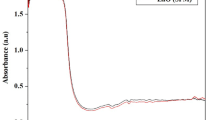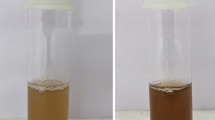Abstract
Arsenite oxidizing Klebsiella pneumoniae strain SSSW7 isolated from shipyard waste Goa, India showed a minimum inhibitory concentration of 21 mM in mineral salts medium. The strain possessed a small supercoiled plasmid and PCR amplification of arsenite oxidase gene (aioA) was observed on plasmid as well as chromosomal DNA. It was confirmed that arsenite oxidase enzyme was a periplasmic protein with a 47% increase in arsenite oxidase activity at 1 mM sodium arsenite. Scanning electron microscopy coupled with electron dispersive X-ray spectroscopic (SEM–EDS) analysis of 15 mM arsenite exposed cells revealed long chains of cells with no surface adsorption of arsenic. Transmission electron microscopy combined with electron dispersive X-ray spectroscopic (TEM-EDS) analysis demonstrated plasma membrane disruption, cytoplasmic condensation and periplasmic accumulation of arsenic. The bacterial strain oxidized 10 mM of highly toxic arsenite to less toxic arsenate after 24 h of incubation. Fourier transformed infrared (FTIR) spectroscopy confirmed the interaction of arsenite with functional groups present on the bacterial cell surface. Sodium dodecyl sulfate-polyacrylamide gel electrophoresis (SDS-PAGE) analysis of 5 mM arsenite exposed cells demonstrated over-expression of 87 kDa and 14 kDa proteins of two subunits aioA and aioB of heterodimer arsenite oxidase enzyme as compared to control cells. Therefore, this bacterial strain might be employed as a potential candidate for bioremediation of arsenite contaminated environmental sites.




Similar content being viewed by others
References
Abbas SZ, Riaz M, Ramzan N, Zahid MT, Shakoori FR, Rafatullah M (2014) Isolation and characterization of arsenic resistant bacteria from wastewater. Braz J Microbiol 45(4):1309–1315
Achour AR, Bauda P, Billard P (2007) Diversity of arsenite transporter genes from arsenic-resistant soil bacteria. Res Microbiol 158(2):128–137
Anawar HM, Akai J, Mostofa KMG, Safiullah S, Tareq SM (2002) Arsenic poisoning in groundwater: health risk and geochemical sources in Bangladesh. Environ Int 27(7):597–604
Anderson GL, Williams J, Hille R (1992) The purification and characterization of arsenite oxidase from Alcaligenes faecalis, a molybdenum-containing hydroxylase. J Biol Chem 267:23674–23682
Andreoni V, Zanchi R, Cavalca L, Corsini A, Romagnoli C (2012) Arsenite oxidation in Ancylobacter dichloromethanicus As3-1b strain: detection of genes involved in arsenite oxidation and CO2 fixation. Curr Microbiol 65:212–218
Arsene-Ploetze F, Koechler S, Marchal M, Coppee JY, Chandler M, Bonnefoy V, Brochier-Armanet C, Barakat M, Barbe V, Battaglia-Brunet F, Bruneel O, Bryan CG, Cleiss-Arnold J, Cruveiller S, Erhardt M, Heinrich-Salmeron A et al (2010) Structure, function and evolution of the Thiomonas spp. genome. PLoS Genet 6(2):e1000859
Bahar MM, Megharaj M, Naidu R (2013) Kinetics of arsenite oxidation by Variovorax sp.MM-1 isolated from soil and identification of arsenite oxidase gene. J Hazard Mater 262:997–1003
Banerjee S, Datta S, Chattopadhyay D, Sarkar P (2011) Arsenic accumulating and transforming bacteria isolated from contaminated soil for potential use in bioremediation. J Environ Sci Health A 46:1736–1747
Branco R, Francisco R, Chung AP, Morais PV (2009) Identification of an aox system that requires cytochrome c in the highly arsenic resistant bacterium Ochrobactrum tritici SCII 24. Appl Environ Microbiol 75(5):5141–5147
Cai L, Rensing C, Li X, Wang G (2009) Novel gene clusters involved in arsenite oxidation and resistance in two arsenite oxidizers: Achromobacter sp. SY8 and Pseudomonas sp. TS44. Appl Microbiol Biotechnol 83:715–725
Chang J, Yoon I, Lee J, Kim K, An J, Kim K (2010) Arsenic detoxification potential of aox genes in arsenite oxidizing bacteria isolated from natural and constructed wetlands in the Republic of Korea. Environ Geochem Health 32:95–105
Chen M, Ma LQ, Harris WG (2002) Arsenic concentrations in Florida surface soils. Soil Sci Soc Am J 66(2):632–640
Cheng HF, Hu YN, Luo J, Xu B, Zhao JF (2009) Geochemical processes controlling fate and transport of arsenic in acid mine drainage (AMD) and natural systems. J Haz Mater 165:13–26
Chowdhury UK, Biswas BK, Chowdhury TR, Samanta G, Mandal BK, Basu GC, Chanda CR, Lodh D, Saha KC, Mukherjee SK, Roy S (2000) Groundwater arsenic contamination in Bangladesh and West Bengal, India. Environ health perspect 108(5):393–397
Daware V, Kesavan S, Patil R, Natu A, Kumar A, Kulkarni M, Gade W (2012) Effects of arsenite stress on growth and proteome of Klebsiella pneumoniae. J Biotechnol 158(1–2):8–16
Ghosh D, Bhadury P, Routh J (2014) Diversity of arsenite oxidizing bacterial communities in arsenic-rich deltaic aquifers in West Bengal, India. Front Microbiol 5:602
Goswami R, Mukherjee S, Rana VS, Saha DR, Raman R, Padhy PK, Mazumder S (2015) Isolation and characterization of arsenic-resistant bacteria from contaminated water-bodies in West Bengal, India. Geomicrobiol J 32:17–26
Hamamura N, Macur RE, Korf S, Ackerman G, Taylor WP, Kozubal M et al (2008) Linking microbial oxidation of arsenic with detection and phylogenetic analysis of As(III) oxidase genes in diverse geothermal environments. Environ Microbiol 11(2):421–431
Hughes MP (2002) Arsenic toxicity and potential mechanisms of action. Toxicol Lett 133:1–16
Jain R, Jha S, Adhikary H, Kumar P, Parekh V, Jha A, Mahanta MK, Kumar GN (2014) Isolation and molecular characterization of arsenite-tolerant Alishewanella sp. GIDC-5 originated from industrial effluents. Geomicrobiol J 31(1):82–90
Kumar S, Stecher G, Tamura K (2016) MEGA7: molecular evolutionary genetics analysis version 7.0 for bigger datasets. Mol Biol Evol 33:1870–1874
Laemmli UK (1970) Cleavage of structural proteins during the assembly of the head of bacteriophage T4. Nature 227:680–685
Lenoble V, Deluchat V, Serpaud B, Bollinger JC (2003) Arsenite oxidation and arsenate determination by the molybdene blue method. Talanta 61:267–276
Lett M, Paknikar K, Lievremont D (2001) A simple and rapid method for arsenite and arsenate speciation. Process Metall 11:541–546
Lowry OH, Rosebrough NJ, Farr AL, Randall RJ (1951) Protein measurement with the Folin phenol reagent. J Biol Chem 193(1):265–275
Mahimairaja S, Bolan NS, Adriano DC, Robinson B (2005) Arsenic contamination and its risk management in complex environmental settings. Adv Agron 86:1–82
Mahtani S, Mavinkurve S (1979) Microbial purification of longifolene: a sesquiterpene. J Ferment Technol 57:529–533
Majumder A, Bhattacharyya K, Bhattacharyya S, Kole SC (2013) Arsenic-tolerant, arsenite-oxidising bacterial strains in the contaminated soils of West Bengal, India. Sci Total Environ 463–464:1006–1014
Mallick I, Hossain SKT, Sinha S, Mukherjee SK (2014) Brevibacillus sp. KUMAs2 a bacterial isolate for possible bioremediation of arsenic in rhizosphere. Ecotoxicol Environ Saf 107:236–244
Mandal BK, Suzuki KT (2002) Arsenic round the world: a review. Talanta 58(1):201–235
Mitra AK, Bose BK, Kabir H, Das BK, Hussain M (2002) Arsenic-related health problems among hospital patients in southern Bangladesh. J Health Popul Nutr 20(3):198–204
Mukherjee A, Sengupta MK, Hossain MA, Ahamed S, Das B, Nayak B, Lodh D, Rahman MM, Chakraborti D (2006) Arsenic contamination in groundwater: a global perspective with emphasis on the Asian scenario. J Health Popul Nutr 24:142–163
Muller D, Medigue C, Koechler S, Barbe V, Barakat M, Talla E, Bonnefoy V, Krin E, Arsene-Ploetze F, Carapito C, Chandler M, Cournoyer Cruveiller S, Dossat C, Duval S, Heymann M, Leize E, Lieutaud A, Lievremont D et al (2007) A tale of two oxidation states: bacterial colonization of arsenic-rich environments. PLoS Genet 3(4):e53
Naureen A, Rehman A (2016) Arsenite oxidizing multiple metal resistant bacteria isolated from industrial effluent: their potential use in wastewater treatment. World J Microb Biotechnol 32(8):133
Oremland RS, Stolz JF (2005) Arsenic, microbes and contaminated aquifers. Trends Microbiol 13:45–49
Oremland RS, Saltikov CW, Wolfe-Simon F, Stolz JF (2009) Arsenic in the evolution of earth and extra-terrestrial ecosystems. Geomicrobiol J 26:522–536
Páez-Espino D, Tamames J, de Lorenzo V, Cánovas D (2009) Microbial responses to environmental arsenic. Biometals 22(1):117–130
Paul D, Poddar S, Sar P (2014) Characterization of arsenite-oxidizing bacteria isolated from arsenic-contaminated groundwater of West Bengal. J Environ Sci Health A 49(13):1481–1492
Prasad KS, Subramanian V, Paul J (2009) Purification and characterization of arsenite oxidase from Arthrobacter sp. Biometals 22:711–721
Qin J, Rosen BP, Zhang Y, Wang G, Franke S, Rensing C (2006) Arsenic detoxification and evolution of trimethylarsine gas by a microbial arsenite S-adenosyl methionine methyltransferase. Proc Natl Acad Sci USA 103(7):2075–2080
Quemeneur M, Sameron AH, Muller D, Lievremont D, Janzein M, Bertin PN, Garrido F, Joulian C (2008) Diversity surveys and evolutionary relationships of aoxB genes in aerobic arsenite oxidizing bacteria. Appl Environ Microbiol 74(14):4567–4573
Rai A, Tripathi P, Dwivedi S, Dubey S, Shri M, Kumar S, Tripathi PK, Dave R, Kumar A, Singh R, Adhikari B, Bag M, Tripathi RD, Trivedi PK, Chakrabarty D, Tuli R (2011) Arsenic tolerance in rice (Oryza sativa) have a predominant role in transcriptional regulation of a set of genes including sulphur assimilation pathway and antioxidant system. Chemosphere 82:986–995
Rauschenbach I, Bini E, Haggblom MM, Yee N (2012) Physiological response of Desulfurispirillum indicum S5 to arsenate and nitrate as terminal electron acceptors. FEMS Microbiol Ecol 81(1):156–162
Rosen BP (1999) Families of arsenic transporters. Trends Microbiol 7(5):207–212
Rosen BP (2002) Biochemistry of arsenic detoxification. FEBS Lett 529(1):86–92
Sambrook J, Fritsch EF, Maniatis T (1989) Molecular cloning: a laboratory manual. Cold Spring Harbor Laboratory Press, New York
Santini JM, Vanden Hoven RN (2004) Molybdenum-containing arsenite oxidase of the chemolithoautotrophic arsenite oxidizer NT-26. J Bacteriol 186(6):1614–1619
Silver S, Phung LT (1996) Bacterial heavy metal resistance: new surprises. Ann Rev Microbiol 50(1):753–789
Silver S, Phung LT (2005) Genes and enzymes involved in bacterial oxidation and reduction of inorganic arsenic. Appl Environ Microbiol 71:599–608
Singh N, Gupta S, Marwa N, Pandey V, Verma PC, Rathaur S, Singh N (2016) Arsenic mediated modifications in Bacillus aryabhattai and their biotechnological applications for arsenic bioremediation. Chemosphere 164:524–534
Smedley PL, Kinniburgh DG (2002) A review of the source, behaviour and distribution of arsenic in natural waters. Appl Geochem 17(5):517–568
Stolz JF, Basu P, Oremland RS (2010) Microbial arsenic metabolism: new twists on an old poison. Microbe 5:39–53
Studholme DJ, Jackson RA, Leak DJ (1999) Phylogenetic analysis of transformable strains of thermophilic Bacillus species. FEMS Microbiol Lett 172:85–90
Vanden Hoven RN, Santini JM (2004) Arsenite oxidation by the heterotroph Hydrogenophaga sp. str. NT-14: the arsenite oxidase and its physiological electron acceptor. Biochim Biophys Acta 1656(2–3):148–155
Welch AH, Westjohn DB, Helsel DR, Wanty RB (2000) Arsenic in ground water of the United States: occurrence and geochemistry. Groundwater 38(4):589–604
WHO (1993) Guidelines for drinking water quality. recommendations, 2nd edn. World Health Organization, Geneva
Wu YH, Feng SX, Li B, Mi XM (2010) The characteristics of Escherichia coli adsorption of arsenic (III) from aqueous solution. World J Microbiol Biotechnol 26(2):249–256
Wysocki R, Bobrowicz P, Ulaszewski S (1997) The Saccharomyces cerevisiae ACR3 gene encodes a putative membrane protein involved in arsenite transport. J Biol Chem 272(48):30061–30066
Acknowledgements
SM is grateful to University Grants Commission, New Delhi for financial support as Maulana Azad National Fellowship (SRF). The authors are thankful to Areef Sardar from CSIR- National Institute of Oceanography, Goa for EDX analysis; AIRF, Jawaharlal Nehru University, New Delhi for TEM–EDX analysis; B. R. Srinivasan, Head, Department of Chemistry and Rahul Kerkar from Department of Chemistry, Goa University for FTIR analysis. SM is also thankful to Sandeep Garg, Head, Department of Microbiology, Goa University for providing laboratory facilities.
Author information
Authors and Affiliations
Corresponding author
Ethics declarations
Conflict of interest
The authors declare that there is no conflict of interest.
Electronic supplementary material
Below is the link to the electronic supplementary material.
Rights and permissions
About this article
Cite this article
Mujawar, S.Y., Shamim, K., Vaigankar, D.C. et al. Arsenite biotransformation and bioaccumulation by Klebsiella pneumoniae strain SSSW7 possessing arsenite oxidase (aioA) gene. Biometals 32, 65–76 (2019). https://doi.org/10.1007/s10534-018-0158-7
Received:
Accepted:
Published:
Issue Date:
DOI: https://doi.org/10.1007/s10534-018-0158-7




